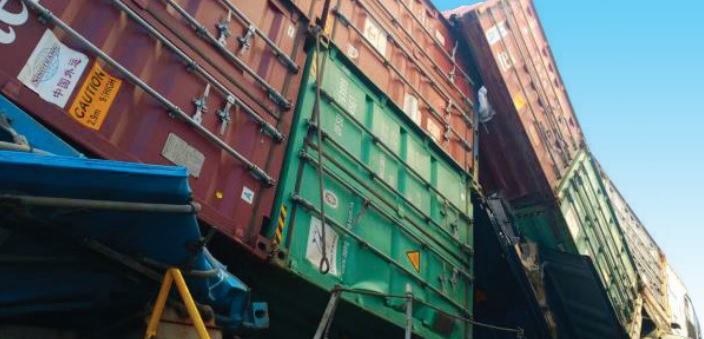A recent run of container loss claims by the London P&I Club has highlighted some of the common contributory factors, emerging from the investigation process. The Club noted that the subject of mis-declared container weights continues to be a problem, however, in this particular run of claims, it was the attending surveyor’s observations regarding cargo securing equipment that ‘catch the eye’.
In these cases, it became clear that several manual twist locks were not correctly locked at the time of the incident. The causes for this were considered to be two-fold – some twist locks were damaged (specifically with locking levers either bent or missing), or the units in service were a mixture of right and left-hand locking units, leading to confusion over the observed status of the twist lock.
Upon investigation, a number of container corner castings and container foundations showed no signs of having a locked twist lock forcibly removed during the collapse, the natural conclusion being that the twist locks were in those cases in the unlocked position. It was also evident that in some cases the degree of wastage of deck/hatch container foundations was such that they were no longer serviceable. As a result, even the best maintained twist lock cannot properly contribute to the planned securing arrangement.
Owners are reminded of the need to ensure that container lashing and securing equipment (including fixed fittings) are included in the ship’s planned maintenance system. It is further recommended that at the same time, the ship’s equipment is all checked for consistency against the provisions of the ship’s prescribed cargo securing equipment inventory within the cargo securing manual.
The London Club, in cooperation with TMC Marine Consultants, has earlier cited general causes of container losses:
1. Packing issues
Some experts believe that approximately 20% of containers at any given time are misdeclared, and that upwards of two-thirds of all cargo claims may be attributed to misdeclaration and poor container packing.
2. Overweight containers
If packing issues are an upstream issue over which carriers have little control, for a long time the real ‘elephant in the room’ has been the overweight containers which, whilst also originating upstream, have a larger downstream impact on a more frequent basis. Under-declared containers can lead to a variety of problems for the carrier, including but not limited to the overloading of lashings and container frames through heavy containers being stowed on light and/or stack loads being exceeded.
3. Inadequate planning
The basis of limiting container weights and combined stack loads is primarily not to overload the capacity of the lashing system and container frames.
4. Poor lashing performance
Improperly selected, improperly applied or poorly maintained lashing gear can significantly influence a stow collapse incident.
5. Fully automatic twistlocks (FATs)
The design of the portable lashing equipment may also, on occasion, be found wanting under certain circumstances. In February 2006, there were four high-profile container losses that occurred in the Bay of Biscay area which were understood to have been as a result of a combination of the use of a new type of twistlock (a fully automatic twistlock) and new larger container ship designs. Although these incidents involved only one particular design of FAT, they caused several of the main lashing equipment suppliers to withdraw their FATs from service.
6. Voyage planning/navigation
Whilst a container stow is exposed to the significant effects of weather, it is the motions of the ship encountered in the course of the voyage – specifically roll, pitch and heave – that have the greatest bearing on the forces exerted on the lashings.
Carriers should acknowledge that Cargo Planners are often obligated to only check that the stack weights are within limits and may not be required to check the lashing forces. Ship checks need to be performed and diverging inputs identified. There should be proper voyage planning to avoid excessive accelerations, including alterations of course or speed, early avoidance of adverse weather areas and timely ballasting taking into account the actual stability condition. Avoiding beam seas to avoid undue rolling is a normal practice on container ships.

































































